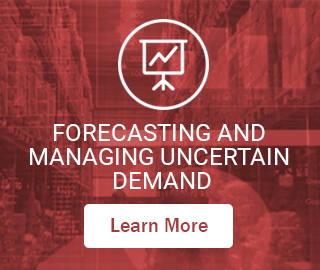At year’s end, we are often caught up in thinking and planning for the coming year. Did 2013 turn out the way you expected? Will 2014 be dramatically different? Are there other factors—things we are planning to do; things we think our competitors might do; outside forces like changing taste, demographics or economics—that might change the course of business in the coming year?
Most companies that do a formal forecast start out with a statistical projection of past sales patterns into the future. Your forecast model should detect and characterize any seasonality inherent in your markets and include that in the projection. But that’s just the first step.
The next thing to consider is product lifecycle. Nearly all products go through a predictable cycle of introduction, acceptance and growth, maturity (demand levels off) and finally decline to obsolescence. These cycles can be as short as weeks or as long as decades. Clothing fashions and consumer electronics would be on the shorter end of the scale, while products like plumbing fixtures and construction equipment would experience longer cycles. In specialized situations like bus fleet management, entire fleets may be replaced over defined transition periods. In any case, the demand forecast should be adjusted to reflect increasing or decreasing demand according to the product’s position in its lifecycle.
Now comes the hardest part—predicting the unpredictable. In general, the future is likely to look a lot like the recent past in a similarity to Newton’s first law of motion: a body in motion tends to stay in motion unless acted upon by an external force. But it’s those external forces that can send your carefully calculated forecast right into the gutter. A competitor might slash their prices to take away some of your market share. New technologies might obsolete your product before the end of its expected life span. Changing tastes or new regulations might stop sales in their tracks.
But good things might happen as well. You might be the one to slash prices or improve your product and take away a competitor’s business. Your product may catch the fancy of the market and sales will skyrocket. A competitor may abandon the business or go bankrupt, leaving you with more opportunity.
Should you plan for these kinds of things? Certainly, to the extent that you can. You may know when you’ll run promotions or phase in the next product line. But the future, by nature, is uncertain. History and your business knowledge of the past lay the foundation for your view of the future. Statistically-based tools can help you create a risk-adjusted forecast, with safety stock recommendations that correspond with the level of risk you are willing to take. Beyond this, your key to success is agility—the ability to adapt to changing conditions. Prepare the best forecast you can, build your plans around that forecast—then monitor sales and market conditions closely and continuously. Look for early warning that things may be going in a direction other than you predicted.
You must be willing to recognize and adapt to changing conditions—in other words, don’t fall in love with your forecast and ignore evidence that it may be wrong. Pride of authorship in this case can be deadly to the business.
It is also important to have contingency plans in place so you will be prepared to make the necessary changes to procurement, production and inventory to respond to the new estimate of demand. The best tools for this are the shortest possible lead times (both production and supplier), good supplier relationships and a clear view of the world and your markets.
Forecasting is difficult mainly because people know it is likely to be wrong and nobody likes to be publicly and visibly wrong. Nevertheless, a good forecast is necessary to position the resources necessary to satisfy customer demands. Just be open to the first signs of change and be prepared to react quickly and decisively.
Dave Turbide, CFPIM, CIRM, CSCP, CMfgE is a New Hampshire-based independent consultant and freelance writer. He can be reached via e-mail at dave at daveturbide dot com.
Related Posts

Make AI-Driven Inventory Optimization an Ally for Your Organization
In this blog, we will explore how organizations can achieve exceptional efficiency and accuracy with AI-driven inventory optimization. Traditional inventory management methods often fall short due to their reactive nature and reliance on manual processes. Maintaining optimal inventory levels is fundamental for meeting customer demand while minimizing costs. The introduction of AI-driven inventory optimization can significantly reduce the burden of manual processes, providing relief to supply chain managers from tedious tasks.

Future-Proofing Utilities: Advanced Analytics for Supply Chain Optimization
Utilities in the electrical, natural gas, urban water, and telecommunications fields are all asset-intensive and reliant on physical infrastructure that must be properly maintained, updated, and upgraded over time. Maximizing asset uptime and the reliability of physical infrastructure demands effective inventory management, spare parts forecasting, and supplier management. A utility that executes these processes effectively will outperform its peers, provide better returns for its investors and higher service levels for its customers, while reducing its environmental impact.

Daily Demand Scenarios
In this Videoblog, we will explain how time series forecasting has emerged as a pivotal tool, particularly at the daily level, which Smart Software has been pioneering since its inception over forty years ago. The evolution of business practices from annual to more refined temporal increments like monthly and now daily data analysis illustrates a significant shift in operational strategies.











